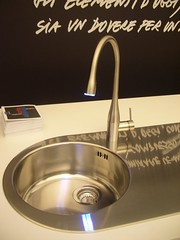Since launching BlinkM in February, I've been focused on the potential design uses of LED lighting. This years' Milan Furniture Fair (aka Milan Design Week, since it's branched out significantly beyond furniture to design of all kinds of consumer products for everyday life) was a good place to survey what consumer product companies think of LED lighting as a way of adding value to their products. The short answer is: not much. Since I was there last in 2006, the industry is still more-or-less in a steady state. As I felt in 2004 when I wrote my Smart Furniture Manifesto, the potential of using information processing as a design material is still largely untapped. LEDs are the most basic form of digital information display, and if they're not being used, it shows that the environment isn't embracing the possibilities of smart furniture.
Will it, ever, or will companies making niche products like gaming chairs move to making everyday products like dining room tables and office cubicle systems? In other words, will appliance and consumer electronics makers become furniture maker and take over the furniture industry? Since those industries are, in some ways, equally as conservative and slow-moving as the furniture industry, it's hard to say, but it points to some interesting possibilities.
Let me start with the three things I thought were most interesting.
Interactive projects
Flos' cubo
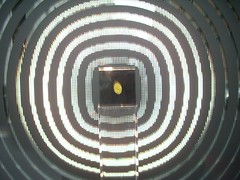
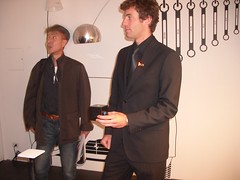
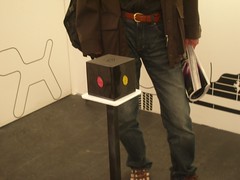
Flos, the lighting company, launched a wireless remote control cube called, cleverly, cubo. Depending on what side is up, it selects a lighting setting. You program it by turning the lights that speak whatever wireless standard they're using (I asked if it was Bluetooth, they said it was not) to some setting and it associates that setting with the cube face. I think it's a bit large and the colors are meaningless to anyone but the programmer, and you could do the same thing with a remote control with 6 buttons in a much smaller form factor, but they're clearly trying to do some magic here and I wish them luck.
Pega Design's Between On & Off series ironic objects
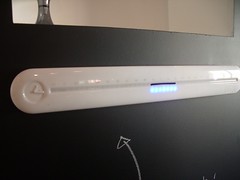
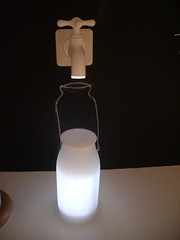
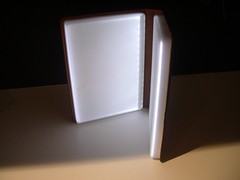
PEGA Design is a Taiwanese company that did a series of interactive objects they grouped into a collection called Between On & Off. The objects aren't particularly useful, they're more iconic and playful, but they're interactive and Pega uses LEDs for most of the interactivity.
The JustDrawIt! light control lets you use a dry erase marker to draw a lighting schedule on a bar (probably with some kind of IR LED/light sensor combination). The TechTap is a faucet that pours data into an LED-filled "milk bottle." I think it's a whimsical way to show how you can show data transfer between physical objects that let you carry data from one spot to another (I think; I only kinda get it). Embrace is a bedside reading light shaped like a book that dims and brightens based on how much it's opened, is also nice.
Jean Louis Frechin and Uros Petrevski's Interfaces
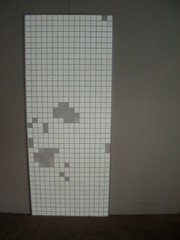



Jean Louis Frechin and Uros Petrevski showed a bunch of interactive objects grouped into a show called Interfaces: Connected Objects. The include the WanetLight, a chandelier that's a 5x5x5 cube of white LEDs that lets people create different light shapes in the chandelier (and maybe reacts to people's movements? I can't tell from the documentation). The WaSnake, which shows SMS text messages crawling across a curvy shelf (I think an RSS feed to news headlines would be more interesting). The WaDoor, a door of electroluminescent pixels. WaPix YJMM is a pair of digital picture frames where one image slides from one picture frame to the other automatically.
I like these objects a lot for their lyricism and although I've seen variations of these ideas in other formats, it's nice to see designers exploring the space.
[5/11/08 Update: Jean-louis Frechin sent me an email pointing out that WaSnake primarily displays RSS feeds, not SMSes, though those work with it, too. WanetLight is operated with a Wiimote, using its tilt sensor, and can react to people in its immediate vicinity (though that functionality was not turned on in Milan). WaDoor is, to use Frechin's words "a Very Cheap Big Screen, in EL." They're working to make the surface interactive, though that functionality was not operational in Milan]
Noninteractive projects
I documented every use of solid state light I could find at the show. What I saw falls into three categories:- Storage lighting
- "Water" lighting
- Appliance lighting
Storage lighting
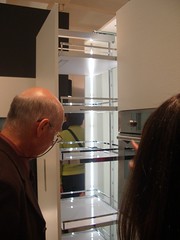
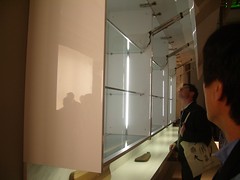
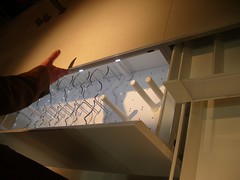
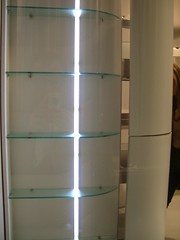
There were a bunch of pieces that used strips of white LED light inside cabinets and drawers to light up the contents, presumably how the light inside a fridge lights up the food.
"Water" lighting
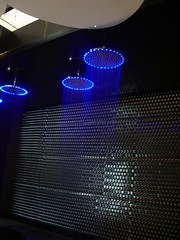
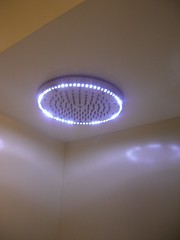
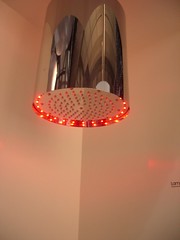
The bathroom design section had more colored lights, almost always cycling through all of the colors. The effect is nice, but it's not clear what the point is.
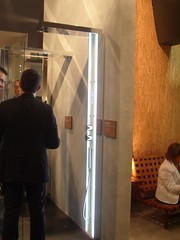
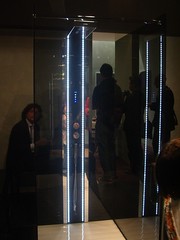
There was also white light inside shower stalls, which holds some amount of promise.
This is a faucet with an LED lighting ring.
Appliance lighting
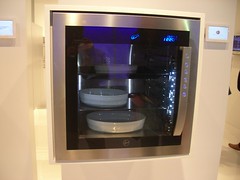
Many companies are putting LEDs in stoves, another extreme environment, which is also interesting for that (if not for how they're actually incorporated). They typically put the lights in between the inner and outer shell, so that the resin of the LEDs isn't directly exposed to the heat, which must have taken some amount of engineering.
Elica, the fancy kitchen hood/purifer people have a whole range of ridiculous hoods, many of which use LEDs. Again, I'm not sure of the point, but at least the rest of the design is also decorative, showing that LEDs can be part of the decoration mix.
Here's another hood that uses LEDs to communicate more:
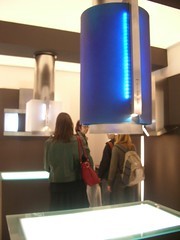
In general, the steps that are being taken are baby steps, and the applications are still primarily decorative (certainly for anything but white light). It's interesting to watch the evolution of smart furniture from all sides of the process of designing furniture because, ironically, Microsoft's Surface table, arguably the first major technology player's entry into the furniture market, was nowhere to be seen in Milan.
